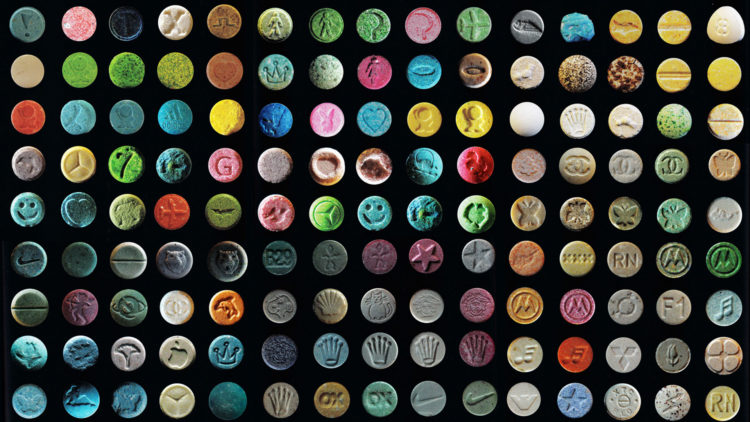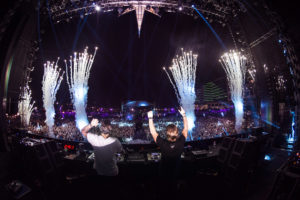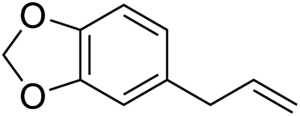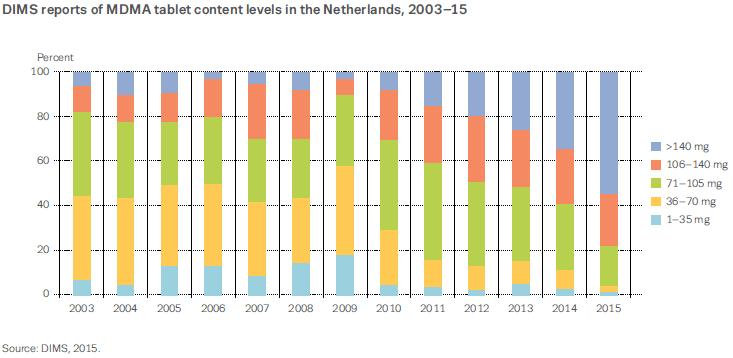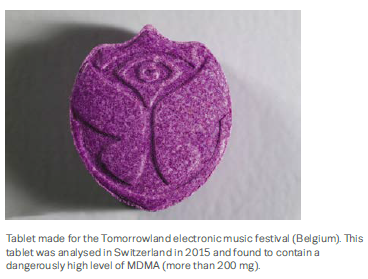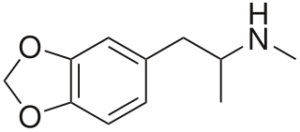 The EMCDDA has released a report which examines recent trends in the MDMA market, with a focus on the European market. Based on their summary of the research in this area, MDMA use is growing, strength has increased, adulterants are less common, and different production methods are taking hold.
The EMCDDA has released a report which examines recent trends in the MDMA market, with a focus on the European market. Based on their summary of the research in this area, MDMA use is growing, strength has increased, adulterants are less common, and different production methods are taking hold.
Research has found the market is adapting to competition and trying to bring in new consumers by offering higher purity products and larger tablets. Sellers have also marketed MDMA differently by attaching well-known logos to tablets which are unfortunately seen as a reliable indicator of a tablet’s purity or source.
I’m going to break down some of the key findings from the study and then delve further into the details. Here are some of the important points:
- The period of MDMA products containing little/no MDMA is over.
- MDMA purity has increased and the market has shifted towards products with larger amounts of the drug.
- Market and law enforcement pressure has given rise to certain notable precursors, trade routes, and production procedures.
- People are starting to use MDMA differently in many countries. It’s become popular partially due to EDM (electronic dance music) events, but use outside of those events is growing.
Note: Many of the trends in this overview apply beyond Europe, but the same is not true for details about the market and industry.
Contents
Background
MDMA is an entactogen that’s been used significantly since the 1980s. Use initially appeared in the United States and it spread to Europe in the mid to late-1980s.
All throughout its history, the drug has been connected to music, in particular EDM (electronic dance music). “MDMA” products (often under the names “ecstasy” or “molly”) have been used continuously, but there was a major drop in actual MDMA in the late 2000s.
For a period of time, MDMA was nearly absent from the market and the products being sold contained other chemicals, such as RC synthetic cathinones.
Since 2010, the market has improved and adulterants are now less common. This has coincided with particularly high-purity and high-dose products, as well as a rise in EDM.
MDMA Markets – Production & Supply
Everything from production to trafficking can often be tied back to organized crime groups (OCGs) operating in Europe. Belgium and the Netherlands have been of notable importance in the industry since they’re home to much of the production that supplies Europe and other parts of the world.
Production in those countries has increased in the past few years, though there are reports of production also occurring in Canada, the US, and China. Asia remains a primary source of precursors like safrole and PMK (piperonyl methyl ketone.)
There are new and growing markets for MDMA, including South America (a notable country being Brazil), southeast Asia, and Australia. Demand from the Asian market may be important because, according to one hypothesis, it’s been a driving force in the creation of more high-purity and high-strength tablets.
Precursors
The four primary precursors have been safrole, isosafrole, piperonal, and PMK. Those precursors have been a source of problems for the industry since they may be controlled or affected by natural shortages.
More recently, a pre-precursor called PMK-glycidate has come about following a shortage of safrole in the late 2000s. It’s played a role in the resurgence of MDMA since it doesn’t come from safrole (no natural shortages) and isn’t internationally controlled.
A shipment (Origin: Shanghai, China Destination: Maastricht, Netherlands) of one tonne of PMK-glycidate was seized in June 2014 in Barcelona. That amount could have reportedly been used to produce up to 7 million tablets.
The Production Chain
A common production path for MDMA involves precursors and PMK-glycidate arriving in the Netherlands or Belgium from China. Other materials (e.g. acetone) are sometimes sourced from other European countries like Germany and Poland.
The OCGs may break up the production of MDMA products so that one group handles pre-precursor conversion, another MDMA’s synthesis, and another tableting. Sometimes everything is handled by the same group, but breaking up the process can be safer when it comes to evading law enforcement (LE).
Even when production is divvied up, it still usually occurs in a single country, namely the Netherlands or Belgium. But, tableting can occur elsewhere (e.g. Germany and Spain).
Along with breaking up the chain of operation, producers avoid LE by using facilities only long enough to produce a single batch. This is in contrast with facilities that operate for months or years. LE often find producers involved in these single batch setups only order the exact amount of materials needed for the batch.
Effectively all of the MDMA used in Europe is produced internally and producers also make MDMA for export, with it arriving in locations like Australia, Brazil, and the US. When MDMA is transported internationally, all modes of transportation are used. With the recent rise of dark net markets (DNMs), the postal service is also being used more often.
Forces Behind The Purity Increase
Market pressure and the existence of superior labs and high-skill chemists are likely the two primary forces behind the increase in purity. There’s even evidence of industrial-scale labs being used to produce the drug, though the prevalence of those labs is unknown.
Most of the MDMA products on the market pre-2005 contained MDMA and they’d occasionally include similar drugs like MDA and MDEA. The market during this time featured few adulterants and individual tablets usually contained well under 150 mg. An example of the low misrepresentation rate comes from France, where from 1999 to 2004, 82% of tablets contained MDMA.
As the late 2000s arrived, the market shifted. MDMA largely disappeared and it was replaced by many other psychoactive substances. By 2009, seizures of “MDMA” tablets in the European market showed the majority contained no MDMA at all.
Conditions in the industry began to improve from 2010 to 2012, depending on the specific location. High purity products returned and this time they were stronger. In the Netherlands, for example, 53% of the tablets tested in 2015 contained over 150 mg, compared to just 3% in 2009.
While adulterants have become a smaller concern in the market, high-strength tablets have caused some problems, prompting official warnings about them in the Netherlands, Belgium, Switzerland, and the UK.
Purity Through Time
Between the 1990s and 2000s, the average strength of an individual tablet was 50 to 80 mg.
Currently, the average strength in the European market is 125 mg and many products come in far above that amount. So-called “super pills” containing 270 – 340 mg have even appeared in some locations.
Role Of DNMs
Dark net markets (DNMs) are having an impact on the MDMA industry. An analysis of 16 darknet sites from 2013 to 2015 found MDMA accounted for ~25% of market demand. Another report from 2015 found it was the third most commonly sold drug, coming in behind cannabis and pharmaceuticals.
A lot of the sales are just to users, but there’s evidence of many transactions taking place that are clearly for resale purposes. One analysis found 45% of MDMA revenue on a DNM was attached to high-price listings, which are for quantities that only make sense if the MDMA is going to be resold by the recipient.
Individual users often report MDMA from these online markets is of a higher quality and there’s reason to believe a trend towards superior quality may exist with DNMs.
What’s In A Tablet?
If MDMA is being sold in tablet form, it’s going to contain other chemicals, but they should largely be inert binding agents and fillers.
Of the psychoactive chemicals that may be present, caffeine is one of the most popular. Combining MDMA and caffeine may not be the wisest thing to do, but caffeine is a mild adulterant.
Some products contain drugs like mCCP, BZP, and TFMPP. These may have MDMA-like actions, but they aren’t usually worthwhile when compared to actual MDMA.
PMMA is another adulterant that is occasionally seen and it’s also one of the most dangerous. Recently, all of the EMCDDA’s alerts regarding adulterants and substitutes have been for PMMA, amounting to 11 alerts from 2011 to 2015.
Marketing
The current MDMA market has a big focus on branding. Symbols of things as diverse as UPS and Superman are placed on tablets, many of which are larger and more colorful than before.
In 2012, Dutch police reported 50 new MDMA tablet designs and that figure grew to 174 in 2014. Some tablet batches are even made for specific events (e.g. Tomorrowland and Amsterdam Dance Event.)
Branding like this has had the unfortunate effect of leading people to believe a tablet’s design is a reliable indicator of quality, strength, or source. It’s not safe to think a tablet is safe or of a certain strength because it has the same design as another tablet that’s been detailed.
MDMA Use & Cultural Context
Locations
An estimated 1.8 million 15 to 34 year-olds in the EU have taken MDMA in the past year, amounting to 1.4% of that population. Depending on the country, the exact amount may range from 0.3% to 5.6%. The highest use tends to be reported in the Netherlands, the Czech Republic, the UK, Bulgaria, and France.
Based on wastewater data, it appears the Netherlands and Belgium are top areas for MDMA use (especially on the weekends), while cities in southern Europe don’t see the drug as much.
Availability Tracks With Use
The more available MDMA is, the more it seems to be used, as shown by increases in use in the 1990s, decreases in the 2000s, and increases since 2010 (especially since 2013).
Most EU countries have found MDMA is being used more widely and people are encountering higher-purity tablets. Though, Latvia and Lithuania haven’t reported an increase in use or purity.
The EDM Connection
Surveys of teenagers find varying amounts of MDMA use, but there’s been a reliable trend towards greater use by young people in the past few years. Among any set of 15 to 18 year-olds, 3-6% will report having used the drug in the past year.
Compared to the general population (adults and non-adults), those who attend nightlife events report significantly greater MDMA use and there’s an especially strong connection between MDMA and EDM.
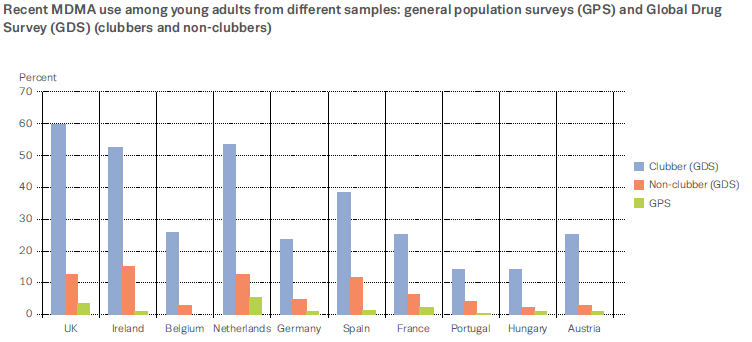 From the 1990s to late 2000s, EDM was more confined to a few large festivals across Europe. MDMA was used throughout this time and there was a move among festivalgoers towards powder/crystals rather than tablets in the late 2000s.
From the 1990s to late 2000s, EDM was more confined to a few large festivals across Europe. MDMA was used throughout this time and there was a move among festivalgoers towards powder/crystals rather than tablets in the late 2000s.
Since 2010, EDM has become more popular and is heavily promoted. This has resulted in frequent massive festivals, with some seeing hundreds of thousands of attendees. In the EDM setting, MDMA is one of the most popular drugs, as shown by surveys, wastewater data, and even the availability of event-specific tablets.
Reasons For Use
People use MDMA in music settings for many of the same reasons they use other stimulants, including to keep going (91%), enhance activity (80%), feel elated/euphoric (78%), stay awake (72%), and become intoxicated (68%).
Though, MDMA does have a unique effect profile that people may prefer over other stimulants (e.g. cocaine or non-entactogen amphetamines) in music settings.
Beyond EDM
It’s becoming more common for MDMA to be used outside of EDM events, suggesting the drug has become somewhat normalized.
Use is now reported in other nightlife settings like bars and house parties, whereas it was almost exclusively confined to the EDM scene in the past.
A Change In Identity
MDMA is often not sold as such and some users may not even know what “MDMA” is. Other names have regularly been attached to it, though “ecstasy” is no longer what the average user may encounter MDMA as.
Rather, names like Molly, Adam, Mandy, and Crystal are more popular among those born during or after the first big wave of MDMA use in the 80s/90s.
MDMA Harms & Deaths
There are some acute risks with MDMA, but serious harm and death are very rare outcomes. When someone is treated for acute toxicity, problems like aggression, anxiety, heart palpitations, and chest pain are regularly reported.
In a one-year period at 16 sentinel centers across 10 European countries, 549 people presented with acute toxicity. Of those, 16 had hyperthermia and rhabdomyolysis more often occurred in that group. Death occurred in two patients.
Around half of those who present with MDMA use have also taken another drug, most often alcohol.
High Doses and Adulterants
Products are more likely to be dangerous if they contain very high doses of MDMA or contain too little/no MDMA, which could mean a user is taking something more potentially dangerous.
Deaths are rare in the EU despite widespread use, but there have been some deaths attributed to very high-dose products in the past couple years. Other deaths have come from drugs like PMMA being sold as MDMA.
Summary
The resurgence of MDMA began in 2010-2012 and it’s been assisted by the availability of a pre-precursor called PMK-glycidate. High-purity products have been especially common in the past few years, as are high-dose tablets that may sometimes contain far too much MDMA.
MDMA use is also becoming normalized, allowing it to shed its attachment to specific subcultures.
OCGs remain important in the MDMA industry, but DNMs are growing in importance, providing a new way for sellers and individuals to obtain the drug.
The primary concerns that now exist with MDMA include:
- High-dose products
- Adulteration with drugs like PMMA
- A lack of information, particularly among young users
- Variability in potency
Given the sort of concerns seen in the present MDMA market, normal harm-reduction measures may be inadequate and somewhat out-of-date. More education is required moving forward, as is a way to eliminate strength variability.
Adulteration, which is often combated by reagent testing, has become less of a concern (at least in Europe). And, even when testing is necessary, it may not be available.

